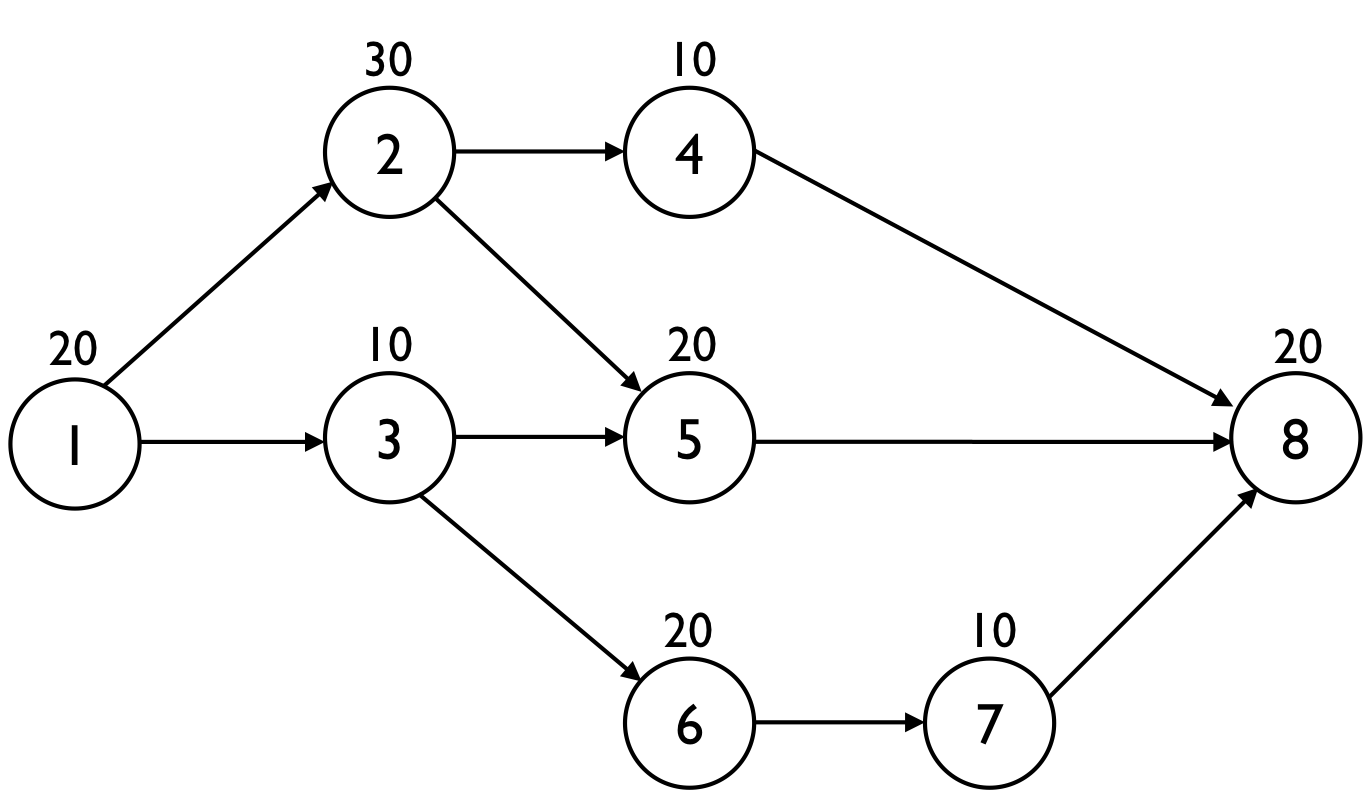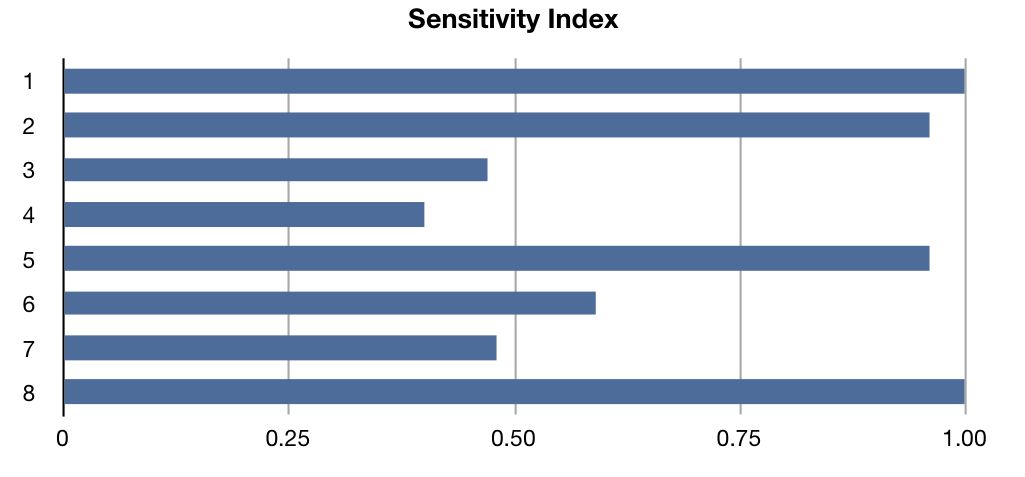Schedule Risk Analysis (SRA) is a simple yet effective technique to connect the risk information of project activities to the baseline schedule, in order to provide sensitivity information of individual project activities to assess the potential impact of uncertainty on the final project duration. A traditional schedule risk analysis requires four steps, as described in “Schedule Risk Analysis: How to measure your baseline schedule’s sensitivity?”, to report activity sensitivity measures that evaluate each activity’s time estimate on a scale of risk. These sensitivity measures can be used by the project manager to distinguish between risky and non-risky activities in order to better focus on those activities that might have an impact on the overall project objective.
In this article, the Significance Index (SI) calculations are illustrated on a fictitious example project network with 8 activities, as displayed in figure 1. The number above each node is the baseline duration estimate (in days).

?
Figure 1: A fictitious example project network
The baseline schedule has a planned duration PD = 90 days and the critical path is equal to the activity sequence 1 - 2 - 5 - 8. However, the baseline schedule is only an estimate of the real project duration and hence, the real project duration and the critical path might differ from the baseline schedule estimates. Consequently, the critical path is a black-and-white view on the critical parts of a project, and should be refined to capture more detailed sensitivity information and the relative importance between the project activities during project progress.
Significance index
The Significance Index of a project activity is a measure to reflect this relative importance between the various project activities, and can be calculated as follows:
SI = E{(AD * SD) / ((AD + SL) * E(SD))}
with
SD: Simulated project Duration
AD: Activity Duration
SL: Activity Slack
E(x): Expected value of x
The SI has been defined as a partial answer to the criticism on the criticality index. Rather than expressing an activity's criticality by the probability concept, the SI aims at exposing the significance of individual activities and their impact on the total project duration. In some examples, the SI seems to provide more acceptable information about the relative importance of activities.
Table 1 displays 10 simulation runs where each activity has a certain duration which might differ from the original baseline duration estimate given in figure 1. The simulated project duration (SD) and the activity slack (SL) for activities 1 to 8 per simulation run are also given. Each simulation run reflects a possible real project progress scenario where unexpected changes in the activity estimates might occur.
Table 1: 10 simulation runs with random activity durations
|
|
1 |
2 |
3 |
4 |
5 |
6 |
7 |
8 |
SD |
SL |
|
Run 1 |
4 |
12 |
1 |
4 |
5 |
4 |
7 |
8 |
29 |
0-0-5-1-0-5-5-0 |
|
Run 2 |
22 |
23 |
14 |
5 |
28 |
26 |
5 |
29 |
102 |
0-0-6-23-0-6-6-0 |
|
Run 3 |
25 |
38 |
12 |
15 |
24 |
20 |
13 |
22 |
109 |
0-0-17-9-0-17-17-0 |
|
Run 4 |
25 |
25 |
15 |
13 |
25 |
25 |
13 |
10 |
88 |
0-3-0-15-3-0-0-0 |
|
Run 5 |
21 |
42 |
12 |
7 |
30 |
21 |
14 |
23 |
116 |
0-0-25-23-0-25-25-0 |
|
Run 6 |
28 |
44 |
7 |
9 |
15 |
20 |
10 |
22 |
109 |
0-0-22-6-0-22-22-0 |
|
Run 7 |
19 |
21 |
14 |
13 |
23 |
24 |
14 |
28 |
99 |
0-8-0-18-8-0-0-0 |
|
Run 8 |
12 |
36 |
14 |
9 |
19 |
17 |
7 |
24 |
91 |
0-0-17-10-0-17-17-0 |
|
Run 9 |
28 |
35 |
7 |
12 |
28 |
27 |
13 |
28 |
119 |
0-0-16-16-0-16-16-0 |
|
Run 10 |
27 |
44 |
6 |
5 |
30 |
10 |
11 |
28 |
129 |
0-0-38-25-0-47-47-0 |
Based on the simulation runs, the significance index can be calculated with the intermediate calculations illustrated in table 2 for activity 2 of figure 1. In the example, the values for AD * SD, AD + SL and (AD * SD) / ((AD + SL) * E(SD)) are calculated for activity 2 with E(SD) the average of the SD column of table 1, i.e. E(SD) = 99.1. The average of the last column of table 2 is equal to 0.96 and is the sensitivity value of activity 2. Although this activity lies on the critical path in the baseline schedule, the significance index shows that the SI of this activity is somewhat lower than 1. Figure 2 shows the SI values for all project activities, ranging between 40% and 100%. More precisely, the values are equal to 1.00, 0.96, 0.47, 0.40, 0.96, 0.59, 0.48 and 1.00 for activities 1 to 8. Obviously, a schedule risk analysis should be done with care for the following two reasons: (1) the input distributions of the activity duration should reflect reality, and (2) the number of simulation runs should exceed 10 to provide more reliable results.
Table 2: Intermediate calculations for the SI of activity 2
|
|
AD * SD |
AD + SL |
(AD * SD) / ((AD + SL) * E(SD)) |
|
Run 1 |
348 |
12 |
0.29 |
|
Run 2 |
2,346 |
23 |
1.03 |
|
Run 3 |
4,142 |
38 |
1.10 |
|
Run 4 |
2,200 |
28 |
0.79 |
|
Run 5 |
4,872 |
42 |
1.17 |
|
Run 6 |
4,796 |
44 |
1.10 |
|
Run 7 |
2,079 |
29 |
0.72 |
|
Run 8 |
3,276 |
36 |
0.92 |
|
Run 9 |
4,165 |
35 |
1.20 |
|
Run 10 |
5,676 |
44 |
1.30 |
?

Figure 2: The significance index values for the 8 activities after 10 simulation runs
 ?
?


